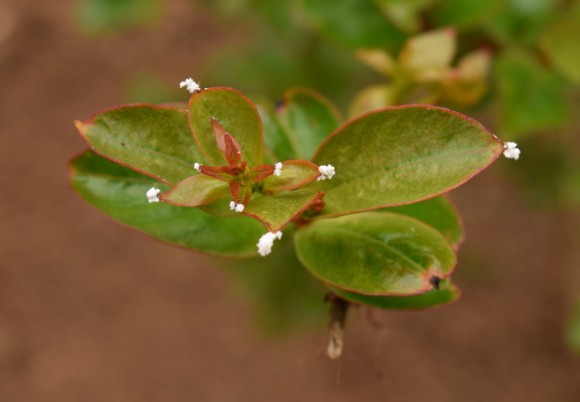
So the other day I noticed my Tonto crape myrtle had this crusty white stuff on it. Not powdery mildew, which sometimes appears later in the year on crape myrtles. Mildew looks like white film on the leaf’s surface. Mine had white stuff on the tips of the leaves.
My first thought was woolly aphids or cottony scale, but it didn’t seem to be a critter. The white things didn’t move when I poked them, and they had no discernible body parts. Weird. So I googled it.

It turned out to be something totally harmless, but I wouldn’t have guessed what it was.
The white stuff was plant sap that had oozed out of the leaf tips in a natural process called “guttation” and then dried and crystallized. The crystals are composed of potassium and sugars and are said to be sweet-tasting. I tasted one, and my resource (Walter Reeves) was right on! That’s probably why that ant is in the picture.
(Let me add that I don’t recommend tasting plant ailments as a method of diagnosis, however.)
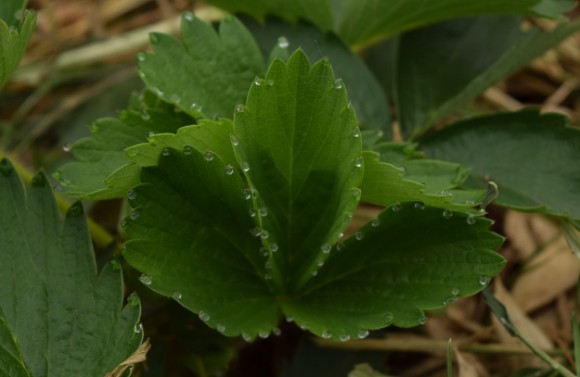
I remembered learning about guttation in HORT 101. It looks like dew, but it’s not. The drops come not from the surrounding atmosphere but from within the plant.
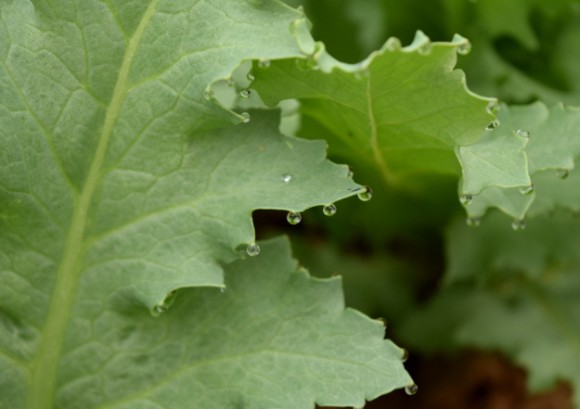
It’s not transpiration, either. Transpiration is how plants usually move water from the roots to the atmosphere, but in transpiration, the fluid exits through openings on the undersides of the leaves, called “stomata.” In guttation, the fluid exits through special openings on the edges of the leaves, called “hydathodes.”
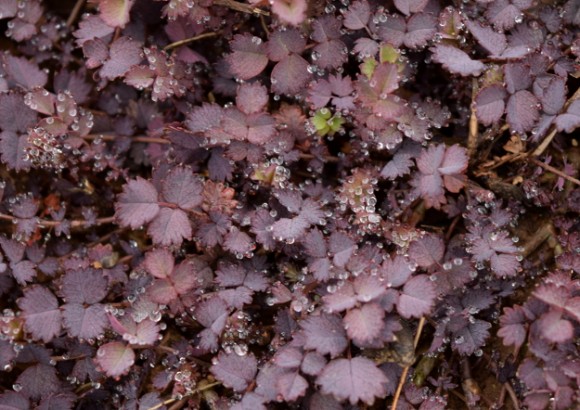
Guttation happens most often when humidity and soil moisture levels are high, and is best observed shortly after sunrise—before the sun’s rays “burn off” the droplets and they evaporate into the air.

Guttation. What an awful word! It sounds like a medical condition: “If you suffer from moderate to severe guttation, ask your doctor about Zanthinox.”
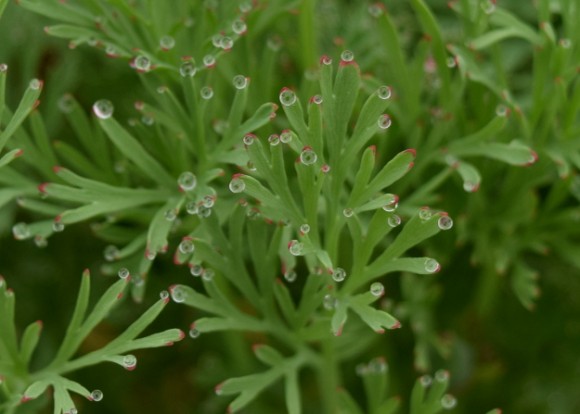
Or at best, a construction term: “The old house was in such bad shape that a complete guttation was in order.”
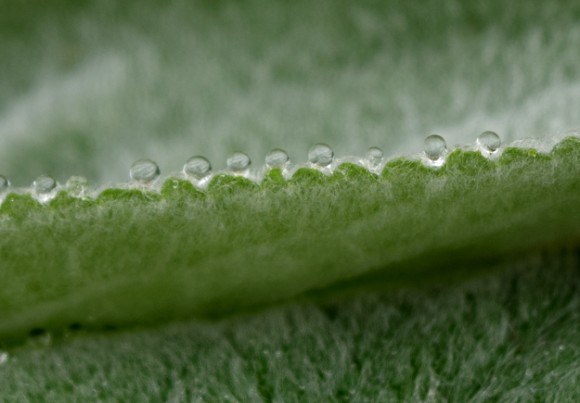
Guttation looks like the work of garden fairies who have been up all night bedazzling the garden. Surely it deserves a prettier name.
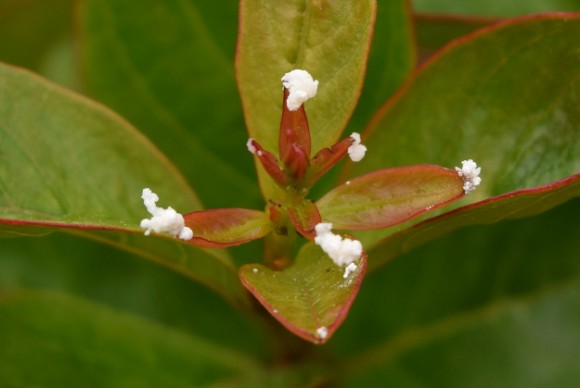
Although, granted, sometimes it does end up looking like cottony scale.


“Guttation” may not be a very lovely name for the process, but the name for the openings in the leaves from which it comes, “hydathodes” is nice – kind of like a Greek nymph.
I learned about guttation once before in my life, but as I mostly do, I forgot. Thanks for the refresher!
You’re welcome, Jane! Yes, hydathodes doesn’t sound as bad as guttation, but it still sounds too technical for something that is obviously done by garden fairies.
I’ve never heard of this but do agree the name is wretched. It sounds like it involves toilet paper and a locked door. But I do like the idea of plants being covered with little sugar balls in the morning. Maybe I should throw a few in my coffee.
Someone else commented that they look like goat cheese. I might sprinkle some on my salad.
Fantastic, I have been looking for this explanation all year, ever since my Natchez crepe myrtles were planted last Autumn and then this appeared on the new leaf growth. I was picking the white lumps off thinking it was something sinister, and may still do next season as I don’t want to attract ants to my myrtles. Thanks ..
Great post, Amy. Love that hort. Came back here to sign up again (changed my email address), so I found a post to “sign up” on. What a library of info your blog is!
Thanks so much, Alyse! Though I don’t post as often as I’d like, I try to make my articles thorough and evergreen.
Thank you much for this explanation. I was looking like crazy to figure out what this is on my 2 year old Crape Myrtle I have grown from seed. Exactly like your picture! I have a green thumb, but don’t know all these technical things 🙂 I have also noticed the little drops on the leaves ofn a peach tree I am growing from seed. That stays clear and does not get white.
Glad I could help you figure it out!
Google to the rescue and your post (fortunately) was the first on the list! Thanks Amy – Glad my Tonto doesn’t have a serious disease!
I don’t know what we did before the internet and Google! Glad I could help.
Such great information. Thank you, thank you!
Thank you so much! I’ve been wondering what this is for over a year now with my new Natchez crape myrtles. No treatment required is the best news of all! Charlie
Thank you for solving this mystery for me in a quick and easy way to understand the problem. It saved me from going to the local nursery and being treated like a idiot. Sorry to say it has happened.
Keep up you good work.
Hi Amy! I just wanted to thank you for this wonderful post! I just planted my new trees a week ago and a few days later is when I noticed the white tips. I talked to many gardeners and nurseries with no explanation of what this was or how to resolve the problem. I got lots of recommendations on what I could treat the trees with, but how do you treat the unknown? I had exhausted my internet search trying to figure it out when I decided I might never be able to solve the mystery. Then late last night I was at it again & hit on your post, I can’t tell you how excited I was and even more so to find that it is harmless 😊 thank you! 💚💚
wow- thank you so much! I was freaking out tonight looking at my crepe myrtles that are only two years old. was pulling it off and spraying soap- whew! thank you for posting/
I think Guttation was done during the Spanish Inquisition.
Last year I planted 3 Crepe Myrtles, 2 were Tonto. This year only 1 of the Tonto has the white growth described perfectly in your posting. I just spent an hour outside picking all the stuff off (didn’t get all of it) and decided to look up this problem. Do you have any idea what only one plant has this issue and not the other 2. They are all planted within 2-3 feet on a small mound in our yard.
Thank you for your post, I feel a lot better.
I add my thanks to the list. I have a Natchez crepe myrtle that’s about 18 months planted and because it’s new (and brought along a weird aphid from the nursery) I’ve been checking it closely. This morning, white spheres had appeared, and google brought me here. *Thank you*. I’m in Oakland CA, zone 9b/10a, where we should be having morning fog but we’re not. It’s unseasonably dry. Maybe the tree is getting too much water (from me).
This saves me from a difficult search of the full grown Natchez’s out front, looking for tiny white spheres!
Hi, thank you for your explanation. I live in Western Victoria, Australia, and have just noticed little white dots on my small crape myrtle. I’m pleased it doesn’t require any treatment. Thank you again.
Ahh! Thank you for the explanation of what I saw just this evening on my Crape Myrtle that I’ve had for years. It wasn’t in the morning and after many years this it the first time I’ve seen it. So glad to know it’s harmless! Google is a wonderful resource! 😊
Thank you Amy, 8 years later! My wife was freaking about exactly this issue on our crepe myrtles. Most searches of “white stuff on leaves” sent us to articles about powdery mildew, but we knew that wasn’t the problem. Have a great summer of ‘23.
As you mentioned, the internet and Google have answered so many of our questions by connecting us with folks like you who share their experiences and knowledge. I tasted the white crystals this morning. They were sweet as you mentioned. Thanks again for sharing!!
Great information. I had not idea. I have been seeing glossy sappy staff on new leaf of my tonto and was wondering what that was, by the end of the day its usually gone.